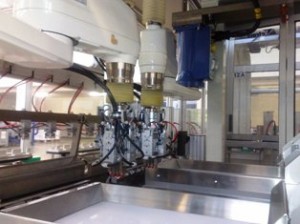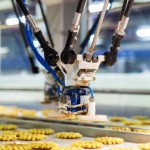Faster robot programming on cosmetics line
 A partnership between National Instruments and Denso Robotics has been a major boon on a packaging line for cosmetics, enabling fast programming, prototyping and testing of an integrated vision and robotics system.
A partnership between National Instruments and Denso Robotics has been a major boon on a packaging line for cosmetics, enabling fast programming, prototyping and testing of an integrated vision and robotics system.
The challenge came when cosmetics packaging line specialist Vetraco approached NI Silver Alliance Partner ImagingLab for a machine vision and robot solution that would identify the position and orientation of face powder brushes, pick them up and place them in a powder case on an eight-slot shuttle. Further complicating the process, the system had to be flexible enough to work with different brushes and box shapes in different batches.
The solution was to use the ImagingLab Robotics Library for Denso to integrate two Denso SCARA HSS-45552 model robots with two vision systems developed with two NI image acquisition boards, and program the entire robot cell with LabVIEW and the NI Vision Development Module.
To achieve the rate of 80 pieces per minute required by Vetraco, ImagingLab installed twin robotic stations. The brushes are loaded on a programmable feeder that shakes to spread them apart and make them available for picking. This feeder is interfaced to the cell via a LabVIEW library.
The vision system based on a NI image acquisition board, an AVT 1,400 by 1,000 pixel CCD camera, and an ImagingLab custom infrared illuminator acquires the images of the brushes, determines their positions, and communicates the coordinates for the part picking to the robot. If there are no parts available for picking, the system shakes the feeder to deposit more brushes under the camera. The system chooses between four possible shaking modes – shake forward, shake backward, shake neutral, and load more parts – to activate based on information from the vision system.
“By adopting the LabVIEW platform, we successfully programmed, prototyped, and tested new robotics applications very quickly.”
The system places the brush boxes’ eight-slot trays in front of the robot at fixed positions. The brushes can have a random position on the feeder and the vision system has to localise the position and orientation of each part because every brush must be placed in its box with the correct orientation. Additionally, the robot has a multiple gripper for four brushes so the vision system has to identify and locate the position of four brushes at each picking cycle. When a tray becomes full, a new one arrives. The robotic cells work 24 hours per day, seven days per week, rejecting any defective parts.
The vision system guides the robots and provides quality control on the parts by measuring the dimensions and verifying the integrity. Using the ImagingLab Robotics Library for Denso, ImagingLab implemented tight vision and robotics integration. As a result, the user can calibrate imaging and robotics with only one operation.
Visit the National Instruments website or the Denso Robotics website for more information.
See all stories for National Instruments or for Denso Robotics
















